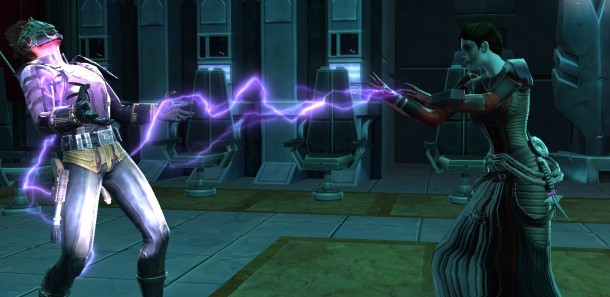Our Verdict
An achievement as an RPG and an MMO, The Old Republic offers something bold and new for gamers. Dont miss out.
PC Gamer's got your back
Editor's note: This review is based on our impressions from our first 85 hours in the game as an Imperial Agent who reached level 35. Some endgame elements were not ready to be evaluated at the time of this review, but as always, we will follow-up this review with constant and regular updates of our impressions as the game progresses here at www.pcgamer.com and in the magazine. — LD
30 minutes had passed since my insectoid ally had asked me. It was a simple question—did I intend to resist his claim to this land?—made complicated by the previous eight hours of politics, betrayal, espionage, and war. I didn't know what to do. After consulting five different people (including my wife over the phone), I reluctantly made my choice on the familiar BioWare dialog wheel and betrayed my always-faithful insectoid allies in order to defend the man who'd just slain his own wife to prove his loyalty. I felt used.
I immediately wanted to load a quicksave and reverse my decision, but I couldn't—unlike BioWare's library of other RPGs, The Old Republic is an MMO and everything you do here is permanent, with unavoidable consequences. An abandoned friend suffers his ineluctable fate; a rescued child remains grateful and secure. It's an unexpected tool that BioWare uses to leverage player emotion and create some of the most engaging, moving story moments I've ever played in an RPG—moments that are light-years beyond what we've seen in MMOs so far.
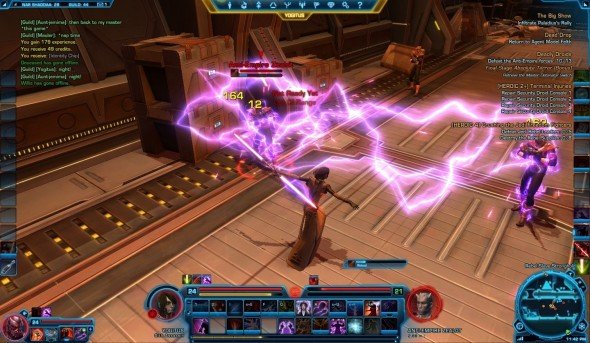
A galaxy far, far away
All 17 of the game's worlds are brought to life with evocative architecture, meticulous set design, and a convincing population. Many quest hubs are the size of small cities with over a hundred soldiers, merchants, doctors, civvies, and the rest going about their business inside. While most of these tertiary characters stay in a single location (we aren't talking Skyrim here), they're almost always acting out a scene—a Jawa trying to protect his droids from Imperial harassers at a starport, soldiers training with a drill sergeant, or a woman receiving saddening news from a friend—and they make destinations feel like places with both a deep past and a future. There is some repetition of environmental models and building layouts, but it's wisely kept to a minimum.
TOR is a BioWare RPG through and through, so you'll be doing the standard BioWare RPG stuff: gathering a crew, meeting interesting people, making moral choices, killing stuff, and upgrading gear. Combat relies on the traditional trinity setup, so you can choose to focus on healing, tanking, or DPS as one of the eight advanced classes available to each faction. A few class designs do break the mold a bit, such as ranged and stealth tanks, but most fall in line with traditional archetypes. The pool of playable species, however, is miniscule—you'll be disappointed if you were dead-set on playing a freaky-looking alien.
I like the game's graphics style—very reminiscent of the Knights of the Old Republic series—though the light-hearted look won't be to everyone's tastes. I think BioWare's bet was a sound one, and there will be plenty of folks more than happy to trade in their bows and arrows for blaster rifles. The sci-fi setting is put to terrific use in the game's consistently dazzling animations and spell effects. The traditional gold sparkles of fantasy game healing spells are replaced by my Agent's floating probes that fall down and rotate around my target, spraying him or her with healing kolto fluid. Blown grenades send enemies sprawling over railings. When I stab an enemy with an electrified dagger, it actually sticks in their chest as their body helplessly convulses and crackles with electricity. And, of course, every blaster blast and saber swing is enhanced with the familiar sound effects and music that the official license grants to TOR.
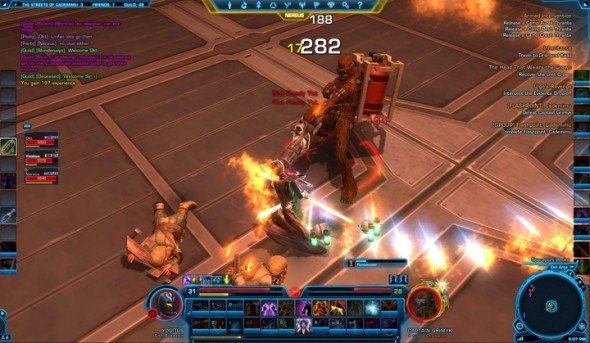
Something borrowed
Not so fresh are the game's quest mechanics, which are rudimentary and mostly drawn from the oldest tricks in the book: kill X, use Y, or talk to Z. In my 85 hours spent on launch servers, I didn't encounter a single vehicle or transformation mechanic that mixed up the abilities I had at my disposal. A few riddle dialog quests popped up, but nothing revolutionary. That said, the novel Bonus Objective system, which usually makes the “kill X” portions of quests optional, does a fine job of breaking out grinding and making it a separate choice. It lets those that don't care to commit genocide on a regular basis stay focused on the story content, which is told through consistently entertaining cutscenes and enlivened with the memorable, nuanced characters we've come to expect from BioWare. Most everything in TOR is voiced, and the voice-over work is, with rare exception, top-notch. Subtle touches, such as my Agent slipping in and out of accents while undercover or the slightly quavering tone of a psychotic doctor, both entertain and deepen the immersion into the stories.
What's more, you can actually provide permanent help to these people, unlike in most MMOs, thanks to TOR's story areas. These seamless sections of the world are instanced for you and your group on the fly (no load screens or delays), allowing everything inside to react, change, and/or explode in response to the choices you make. We've seen similar technology used in World of Warcraft and a few other MMOs to progressively alter an environment down a linear path that all players share, but BioWare uses it to custom-tailor the world for your character and his or her personal story. That single change is revolutionary: your choices matter, and will affect the world you and your friends play in forever.
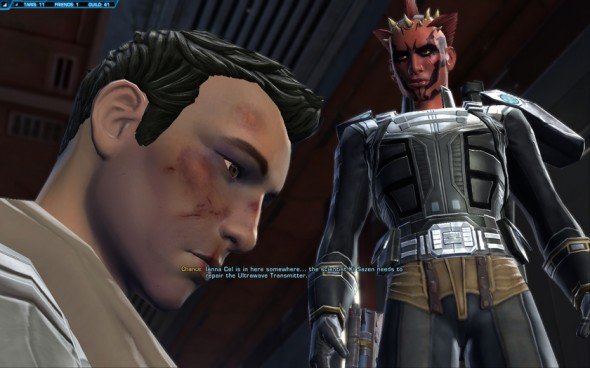
Go away, Gavin
My biggest concern going into TOR was that the focus on storytelling would restrict our ability to play with friends and guildmates, but I was overjoyed (and, frankly, quite surprised) to find that it wasn't a problem at all. I played on-and-off with my aide-de-camp, Gavin, during the first 35 levels of our characters, and we never once had a problem finding content to do together or joining each other on our class quests. The mind-blowing ability to holo-call into your groupmates' conversations from anywhere on the planet (you show up as a translucent projection of yourself) is liberating, allowing you to adventure with your friends without having to stumble about like conjoined twins.
But even though I could quest with Gavin, I wasn't sure I'd want to. Making moral choices by committee can be tricky for control freaks like me. When a multiplayer conversation option pops up, everyone in your group selects the choice they want. Then a dice roll determines who gets to respond. The first time Gavin's evil Sith butchered someone begging for mercy, I was outraged. How could he? I felt invested in and protective of my softy Sith Agent and his trajectory, and Gavin ruined my story.
But, on second, calmer thought, I realized I was just playing a different story: the story of an unlikely group working together to defeat a common enemy. It's a very Star Wars theme, and, much like the inability to load quick saves, adds a depth and dimension to roleplaying. There'd be a similar difference between playing Dungeons & Dragons by yourself and with a full group of friends. Sure, another player will inevitably piss you off by randomly grabbing an NPC and hurling them into a fire, but that's part of the spontaneity that makes roleplaying in a group so great. It's an awesome, unscripted RPG experience that you can only have in The Old Republic right now.
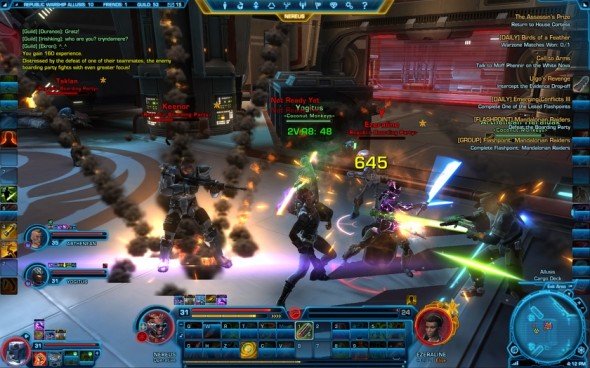
Keeping it casual
Spurred on by the unexpected narrative I was experiencing with Gavin, I decided to try grouping with random players. Heroic quests are exactly what commitment-shy gamers like myself need to get grouping: open-world story areas along your questing route with tough enemies that two to four players can knock out in 15 minutes. They're prevalent on every planet, very casual, and non-threatening. They're the MMO equivalent of asking someone to join you and your buddies for drinks after work. Hey bro, wanna come hack a few droid terminals with us? I grouped up while leveling more often in The Old Republic than I have in any other MMO I've ever played—by a very large margin—but it was always by choice.
Groups looking for challenges with more bite have Flashpoints, TOR's four-person instanced dungeons. Their difficulty ramps up as you level, and high-level Flashpoints have complicated fights that are very challenging, even for coordinated groups. Thankfully, the penalty for death throughout TOR is next to nothing: players can self-resurrect wherever they died with no corpse run and a 10-second period of unbreakable stealth to move away from what killed 'em.
The only major hindrance to teamwork is the very noticeable lack of a looking-for-group tool. A very limited attempt can be found in the social menu, but it's so worthless that it's borderline insulting.
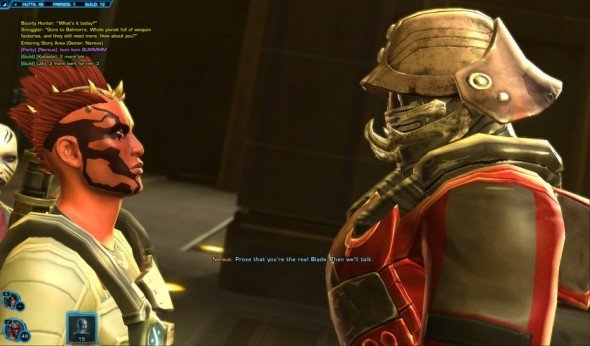
Your story
In MMOs, we usually travel around the world playing through the stories of other people. Quests revolve around the problems and desires of the quest-givers because our characters don't have any (other than the insatiable desire for XP and loot). But you have a story in TOR and all of your adventures revolve around it: you go places because you have business to take care of there. It may seem like a modest difference, but being the center of the universe in a personalized, branching narrative weaves a strong sense of meaning and purpose into everything you do in the game.
I created my Imperial Agent to be a champion of the people—someone who signed up for military duty to protect the innocent of the Empire from enemy attacks. And it worked well, for a while. I picked all the obvious light-side options. I used cool tech like spinal-implanted holoprojectors that disguised me as a service droid to infiltrate terrorist cells and save lives. But as the story went on, I began to find out that the world of an Imperial Agent is not so black-and-white. My enemies were constantly changing, and they weren't always the people I assumed them to be.
Without spoiling plot details, I'll just say that I was very impressed by the overarching story TOR empowered me to create: one of a naïve agent trying to do the right thing in an Empire filled with both evil and noble people. Around level 15, I even turned down a perfectly good quest because I thought my character would have refused it (an MMO first for me!). My character had gotten sick of being told to exterminate the native populations every time he arrived on a planet, and he started to wonder if he was the bad guy. The story evolved almost perfectly with my own narrative—it was on that same planet that BioWare tested my resolve by putting me in the situation described at the start of this review: the same native population that I'd championed now demanded the blood of a betrayed man trying to redeem his family.
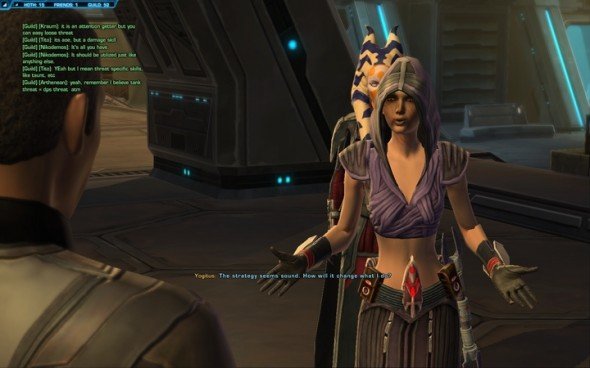
Constant company
A few people are going to want a say in what you do in that big story of yours. Namely, the members of the crew that you assemble while playing. TOR's companion system lets you have one crew member out fighting with you at any time, and all of them can be customized with new gear and appearance options. This may not be new for BioWare RPGs, but it's one of the most innovative and successful elements of TOR as an MMO, providing you with an ever-present audience that reacts to and reflects your choices, via dialog and affection/romance options.
Each class recruits different companions, each with their own unique quirk and backstory. As a level 35 Imperial Agent, I've gathered a violent anarchist, a groveling robot, a diplomat who's merged with the hive mind of an insectoid species, and a doctor who can transform into a space werewolf at will.
Crew skills are the game's crafting system, and provide the usual activities—gather materials and use them to build weapons, armor, and consumables—with a few added twists. Gathering professions also allow you to send companions on missions, which removes access to that companion for 5-20 minutes and gives them a chance to return with crafting materials, credits, light-side and dark points, new recipes, and skill points. It's a decent system for people that don't want to spend the time gathering and crafting themselves, but it can get fairly annoying to have to continually send companions on new missions every few minutes—there should be an automated option.
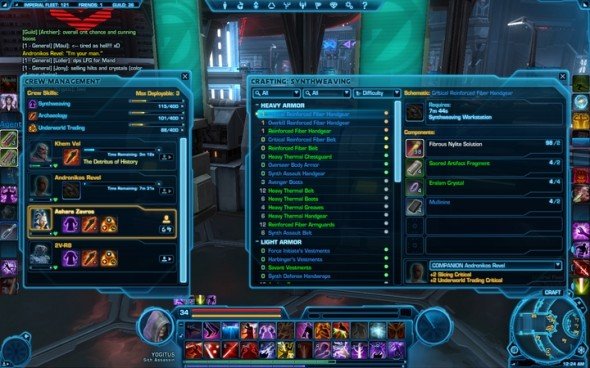
The little things
It wasn't until I discovered that you could reverse-engineer items in TOR to discover new recipes that I began to really get drawn into the crafting system. Suddenly, there was a whole complement of unlisted recipes out there for me to work toward. It's a rarely-used concept that's expertly implemented to give crafters another way to really hone in on the specific areas they want to specialize in.
Another wonderful surprise I unearthed while item-tinkering was moddable gear, select weapons and armor whose stats are fully decided by the modification items dropped into them. Once you find moddable gear with a look you like (or a helmet that changes your voice in a cool way), you can conceivably keep it forever, tossing in new modifications to boost the stats as you level up.
It's a great system that helps you establish a unique look in the universe, and its interface is very well designed. The only problem I had was trying to figure out which stats were best for my character. Ambiguously named stats like Surge aren't explained, and I had to go digging through sub-menus in my character pane to even get a hint at what they offered me.
TOR is full of clever new approaches and tweaks to long-standing MMO features. The auction house automatically suggests buyout prices to undercut the lowest seller; datacrons are nestled on every planet, offering small permanent stat boosts; and there's a full codex stuffed with lore, backstories, and interesting info for the knowledge-seeker. The only major disappointment on this front were achievements, which appear as tiny, uninspired codex entries—clearly a hastily-built afterthought.
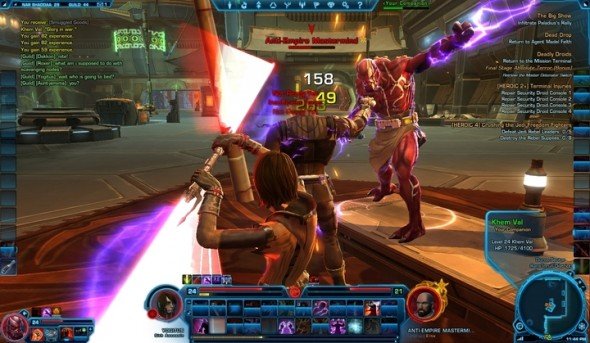
Shooting up the place
Where The Old Republic makes the flimsiest attempt to break the mold is in its combat design: a very traditional click-to-activate ability system that borrows heavily from the big MMOs of recent years. It's enjoyable enough to play with, and has a few nuances, but will ultimately leave MMO vets with a sense of déjà vu at a time when most are eagerly looking for something different.
The 16 advanced classes do, however, offer a strong breadth of playstyles, ranging from ruthless Sith to tricky Smugglers, and most can fulfill two roles in groups, depending on the skill tree you choose to specialize in. Skill trees are very different from one another, but there's almost zero room for customization within each of the trees, so you won't be able to experiment much after you settle on one.
To the stars
Around level 15, you gain command of your own starship, which matches the style of your class, and are free to cruise around the galaxy. You can march imperiously around your ship like you can in Mass Effect, but alas, your ship is tiny and there are only a few interactive spots.
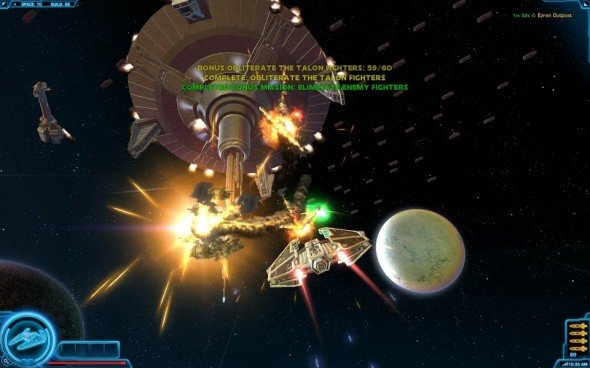
Your ship can see action in any of the dozen or so space combat missions drizzled around the galaxy map. In each, your ship proceeds along a fixed path as you use your mouse to target enemy fighters and battlements on enemy capital ships and take a few minutes to complete. Ship combat is a pleasant diversion that breaks up your questing routine, but it's definitely not why I'd recommend TOR.
No fair, that's cheating
Likewise, I'm lukewarm about the PvP elements, at least at early levels. I've played the three instanced PvP WarZones 25 times, and most matches had a very broad range of players (anywhere between levels 12 and 50). Almost without exception, the highest level players—who have the most skills and skill points at their disposal—dominated the match. The measures put in place to balance incongruous player power do help at higher levels, but PvP is often full of frustration as a low-level player.
These annoying balance issues will hopefully be alleviated at 50, or when more players are made available to the match-making tool—either by BioWare deciding to implement cross-server sign-ups or simply after people stop questing 24/7—allowing the game to force tighter level brackets. The WarZones house some fun gameplay (especially Huttball, which is a twisted version of soccer with flame pits, acid pools, and death) and it'd be a shame if you had to avoid them until max level to find a fair fight.
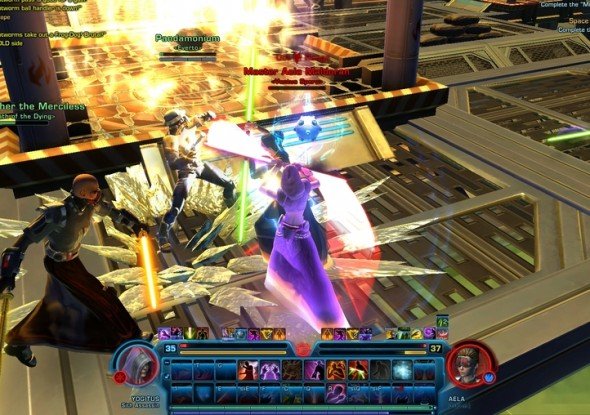
The game's designated open-world PvP zones look extremely promising. Particularly the endgame planet Ilum, whose expansive, intricate battlefield filled with battling war machines and giant turrets is entertaining even without other players in it. They're currently ghost towns as players focus on leveling, but I hope that the zones live up to their potential to serve as bloody hangouts for PvP enthusiasts like myself.
Tech specs
BioWare hit a big homerun with server stability. I didn't hear of a single server crash in the entire first week, and the constant addition of new servers kept queue times reasonable. Inside the game, things were a bit creakier. My client never crashed, but the typical MMO bugs showed up to cause problems, like a few broken quests, unusable gathering nodes, and UI glitches. I only saw reports of one game-breaking bug, but it was fixed on launch day.

Into the future
A lot of questions remain for The Old Republic, particularly regarding the endgame. We know that hard-mode Flashpoints, raids, and PvP areas await us at max level, but we don't know if they'll prove diverse and interesting enough to keep our attention for the long-term. If the endgame consists of gear-grinding and standard raid encounters, it'll have a very jarring effect on those who loved playing through stories for the previous 200 hours. I'm also concerned that the need to record new voice-overs for every bit of new dialog will slow down production of content updates and make the team more likely to focus only on raid content post-launch.
But that's all speculation for now. What I know for certain is that it takes close to 200 hours to level a character to 50, and there are eight different class stories that I intend to play through. There's a ridiculous amount of content in The Old Republic. The game's quality is consistently outstanding and, if you enjoy RPGs at all, the price tag is easily justified—even if you never step foot past max-level.
The Old Republic plunges players into the Star Wars universe we've always wanted to live in, and succeeds as both and RPG and an MMO. And perhaps just as thrilling, there's an oversized Bantha's worth of potential in expanding areas like space combat and the companion system, or in adding new features like guild housing. This one's got a long, bright future ahead of it.
An achievement as an RPG and an MMO, The Old Republic offers something bold and new for gamers. Dont miss out.
